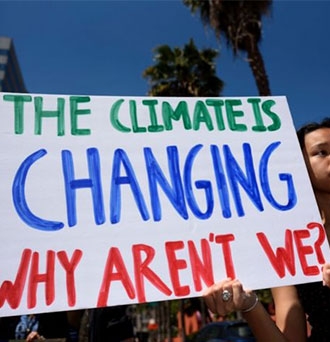
A year before the 2018 elections, Nathaniel Stinnett vowed to raise an “army of environmental super voters” to rival the National Rifle Association.
His nonpartisan Environmental Voter Project ultimately persuaded 58,961 eco-conscious voters in six states ― Colorado, Florida, Georgia, Massachusetts, Nevada and Pennsylvania ― to cast ballots for the first time last year.
Now, ahead of the 2020 election, Stinnett is doubling his effort, targeting millions of untapped voters and adding six new battleground states: Arizona, Virginia, New Mexico, North Carolina, New Hampshire and Maine.
“We’re not going to let a single environmentalist stay home on Election Day,” Stinnett said.
To identify voters, the four-year-old Environmental Voter Project builds profiles based on the kind of demographic and behavioral data advertisers use, then runs a series of polls to verify the data and determine how likely voters are to list environmental issues as their political priority. It then runs the profiles through an algorithm that scores voters based on how likely they are to be “super environmentalists.” Finally, the group weeds out people whose public voting records show they turn out for most elections.
What remains is a pool of registered voters who don’t need to be sold on the realities of the climate crisis ― they just need to be persuaded to turn out on Election Day.
That’s where the Environmental Voter Project’s more than 3,000 volunteers come in ― to mail flyers, send text messages and knock on doors. The group deliberately avoids talking about environmental issues. Instead, it deploys classic persuasion techniques: shaming voters for missing elections that neighbors cast ballots in, reminding them when and where the next polls are, and promising to follow up.
“We’re not focused on one election,” said Stinnett, a veteran campaign strategist in Boston. “We’re focused on changing the electorate.”
Next year, the Environmental Voter Project is eyeing 5 million new voters ahead of local, state and presidential primaries. By the time the general election takes place in November, “we’ll still be targeting 2 million environment-first voters who’ve never voted in a single election before,” Stinnett said.
“We expect that number to grow because millions are expected to register for the first time,” he said.
The group raised about $475,000 in 2017. Last year, it hauled in over $1.5 million. Billionaire Jeremy Grantham, the British financier who’s pledged roughly $1 billion to climate causes, is one of the primary funders, as Grist reported last year. But about 2,000 donors gave $100 or less each over the past year, Stinnett said.
“No one is going to confuse us with Bernie Sanders,” he said, referring to the Democratic presidential candidate’s unrivaled base of small donors. “But this year we are raising money twice as fast as we did last year. People are really excited about this work we’re doing.”
The expansion comes as the climate crisis is emerging as a priority ahead of the 2020 election. Nearly 2,000 candidates for public office have disavowed donations from the fossil fuel industry. Millions of students are slated to go on school strikes next month to demand climate action. Even avowedly centrist candidates for the Democratic presidential nomination are proposing multitrillion-dollar plans to slash planet-heating emissions and overhaul drinking water infrastructure.
We’re not focused on one election. We’re focused on changing the electorate.
Environmental Voter Project founder Nathaniel Stinnett
It’s a dramatic reversal from the 2016 election, in which climate change was virtually ignored. But the shift comes in response to mounting evidence that the cumulative effects of centuries of industrial emissions are starting to show. Fires are burning from the Arctic to the Amazon to Central Africa. Greenland is losing billions of gallons of ice per day. Plastic pollution, an oil byproduct, is now so widespread it’s found in rain and snow.
As of last month, 84% of Democrats and Democratic-leaning independents said climate change is a major threat to the country’s well-being, up from 58% in March 2013, according to a Pew Research Center survey released this week. That compares with 27% of Republicans and Republican-leaning independents, up from 22% in 2013. But the Amsterdam-based polling agency Glocalities found 58% of Republicans “agreed” or “strongly agreed” with the statement “I worry about the damage humans cause the planet” ― an 11% increase from 2014.
That kind of political sea change allowed the Environmental Voter Project to refine its model. Where in past elections the group targeted voters who listed the environment among their top two political priorities, it now only focuses on those who rank it first.
“We realized there are now enough of those people that we can accurately identify them,” Stinnett said. “If there aren’t enough climate-first people, it’s hard to build a model to help you identify them. You have to have a significant enough number. Now we do.”
